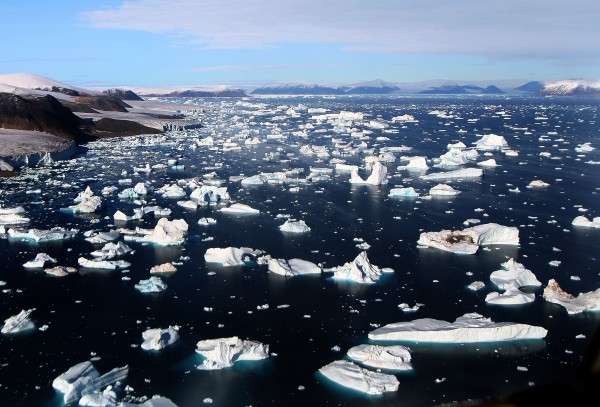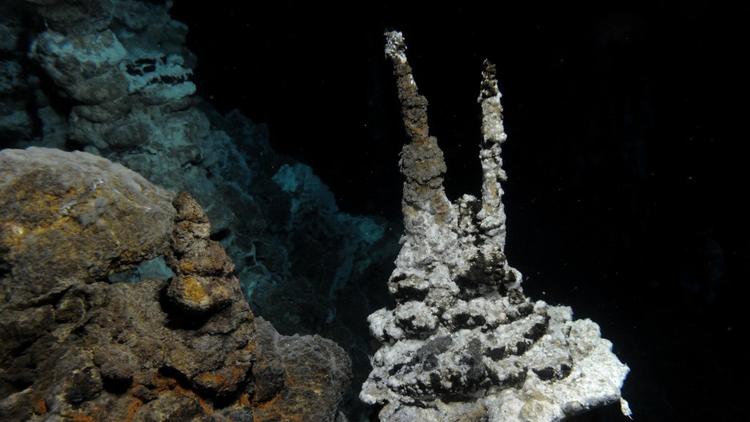The Arctic might seem like a desolate place, but in fact new research suggests a lot of vibrant activity beneath its rapidly diminishing sheets of ice, with a rather surprising find hidden rather deep within the hydrothermal vents at the floor of the Arctic Ocean, where scientists discovered a new and unusual organism which may finally bring to light a significant evolutionary link from the days when life on Earth was simple, comprised of a single cell to when cells became multiple and further complex life forms first took shape.
The recently discovered microbe along with its relatives belonged to the group Lokiarchaeota, named for the trickster god from Norse mythology. They were described in depth in the latest issue of the journal Nature – single-celled organisms who display a rather unusual mix of traits more commonly found among eukaryotes — the taxon that consists of all complex cellular life forms on Earth – including all species of animals, plants and fungi. Even the single-celled protozoan such as amoebas are eukaryotes.
Evolutionary biologists have estimated that the earliest line of the eukaryotes first evolved some two billion years ago, in what was perhaps the most significant transition in the history of life on this planet – the moment at which it was determined beings like us would one day exist. However, until now there has been very little evidence of when these events began to take place, with few fossilized remains to help them map out the gradual process along the way, and a lack of transitional forms from prokaryotic to eukaryotic.
On Wednesday, a team of scientists changed all this when they proudly announced the discovery of such a transitional form. In the far depths of the Arctic Ocean, where just enough heat circulates to encourage life, the scientists discovered microbes which contain many — but not all — of those features which had previously only been singular in eukaryotes. These microbes could provide us with an indication of what the precursors of complex cellular organisms actually looked like.
“This is a genuine breakthrough,” said Eugene Koonin, an evolutionary biologist at the National Center for Biotechnology Information who did not partake in the research. “It’s almost too good to be true.”
Back in the 1970s, scientists picked up the first major piece of evidence about how life evolved from a single cell to many. Carl Woese, a microbiologist from the University of Illinois, along with his colleagues looked at the genetic material across different species in order to reconstruct the tree of life, an effort that would later become the scientific practice of phylogenetics. This analysis broke life forms down into three major branches.
The first branch included bacteria, with such familiar species as E. coli, located in the intestines of living animals. A second branch was described by Dr. Woese as archaea, consisting of the lesser-known species of microbes, extremophiles, which thrive in high stress environments such as bogs or hot springs. Eukaryotes, which comprise the third branch, have much more in common with archaea than they do with bacteria, and are more closely related to the former.
Over the last four decades, during which scientists identified new species of microbes and created powerful new ways for comparing their DNA, Woese’s tree of life has become clearer. Many of the most recent studies now indicate that eukaryotes are in fact not a third individual branch. Rather, they evolved from the archaea.
Thijs J. G. Ettema, a microbiologist at Upssala University in Sweden, was particularly enamored by the fact that many species of archaea closely related to eukaryotes grew colonies on the deep sea floor. It remains likely that in the near future, scientists could discover even closer relatives between the two, hiding near the hydrothermal vents.
It was discovered quite by accident, when Steffen L. Jorgensen, a microbiologist from the University of Bergen, was digging up samples of sediment at a full two miles beneath the surface of the Arctic Ocean. An initial glimpse of this sediment revealed several types of archaea living among the layers. Dr. Jorgensen then offered some of his samples to Dr. Ettema so he could take a closer look.
Dr. Ettema and his colleagues took it a step further, attempting to extract DNA out of the sediment for further analysis, which is quite a risky undertaking.
Dr. Jorgensen was only able to provide a teaspoon size amount of the sediment, one that Dr. Ettema was sure couldn’t contain too many microbes.
As the environment they are used to is cold and dark, the microbes barely grow. If you offered a spoonful soil out of your own backyard, it would likely contain a million times the amount of microbes.
It soon became clear that Dr. Ettema and his colleagues would have to spend just about every bit of the sediment just to get enough DNA for an accurate analysis. Any accidents that might happen along the way would leave them nothing to study.
“There was just one shot,” Dr. Ettema recalled.
Luckily, Dr. Ettema and his colleagues were successful in their experiment. It so happened that this particular sample of the sediment held DNA carried from a lineage of archaea that was unlike any kind ever discovered before. The scientists decided to call it Lokiarchaeum, for the hydrothermal vent near where it was found, which is known as Loki’s Castle.
Analyzing the DNA, the researchers found that Lokiarchaeum is far more closely related to eukaryotes than any other known species of archaea. But even more surprising was that it had genes for many traits that had only been found previously in eukaryotes.
Among the bundles of genes they discovered were ones that coded for special compartments within eukaryote cells. These compartments, which are known as lysosomes, allow the eukaryote cells to eliminate any defective proteins.
All eukaryotes also possess a cellular skeleton which is constantly being rebuilt and torn apart as their shape changes. Dr. Ettema, along with his colleagues found that many of the genes in Lokiarchaeum code for the same type of proteins necessary for building such a skeleton.
It could be likely that the Lokiarchaeum use their skeletons for crawling over surfaces in the same way that protozoans do. Lokiarchaeum’s genes also indicate that they may be able to swallow up molecules or smaller microbes just as eukaryotes do.
At the present time, Lokiarchaeum appears to be far more complex than other archaea and bacteria, although not as complex as true eukaryotes. The new study indicates that they lacked a nucleus and mitochondria.
But Dr. Ettema’s discovery sheds light on how a creature resembling the Lokiarchaeum may have subsequently evolved into the first full-blown eukaryotes.
After the ancestors of eukaryotes had developed a complex skeleton, the second major step could have been the beginning of mitochondria, which provides energy to the cell.
Scientists have long known that mitochondria evolved from bacteria. They carry their own DNA, which more closely resembles the genetic strands found in free-living bacteria than the genes within the cell’s nucleus.
A number of the researchers propose that the common ancestors of all eukaryotes consumed some free-living bacteria. The bacteria became mitochondria, providing fuel for their host cell.
Lokiarchaeum, which holds the potential to graze for microbes, may be exactly the type of microbe needed for this scenario.
Once the early eukaryotes developed mitochondria, they acquired the energy needed for fueling a much larger and more complex cell. In 2006, Drs. Koonin and William Martin at the University of Düsseldorf suggested that the development of mitochondria encouraged the gradual evolution of the cell’s powerhouse – a nucleus.
The two different sets of genes could cause a whole host of damage, were they to interfere with each other. Drs. Koonin and Martin suggested that eukaryotes gradually build a barrier to keep them separated.
As much as the Lokiarchaeum’s genes may reveal, there are limits on how many clues they can give the scientists. “We don’t even know how big the cells are,” said Dr. Ettema.
Dr. Ettema and his colleagues are now focusing on the Lokiarchaeum microbes. They’ve acquired some new sediment samples, and they are now able to determine how many microbes are inside them. Unfortunately, due to the pressure and harsh lighting of a laboratory setting, the microbes often die out before the scientists are able to find out much about them.
So the researchers have another task lying ahead: how to best recreate the conditions suitable for the growth and survival of these microbes will replicating the extreme temperatures and high pressure that the Lokiarchaeum have grown accustomed to. Before they can do that, however, they still need to determine some other factors necessary for the survival of the microbes, such as the type of carbon necessary for their survival.
“It’s definitely not easy,” said Dr. Ettema, “but we’re not giving up. There are so many questions — this is a whole new biology we have to study.”
|
James Sullivan
James Sullivan is the assistant editor of Brain World Magazine and a contributor to Truth Is Cool and OMNI Reboot. He can usually be found on TVTropes or RationalWiki when not exploiting life and science stories for another blog article. |



